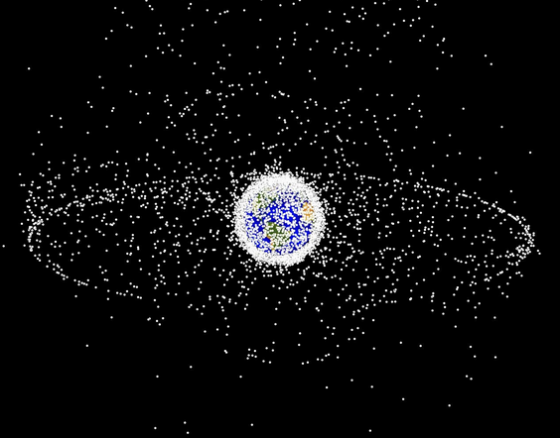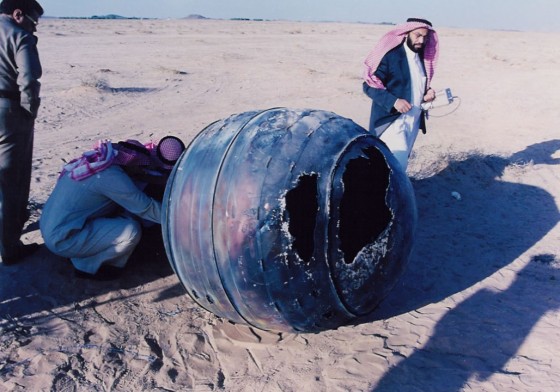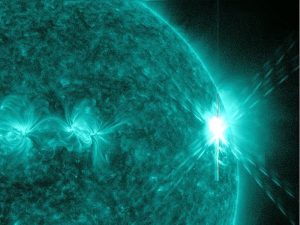 With space labs, astronaut gloves and even a toothbrush floating in space, is there no limits to where we’ve flung our junk?
With space labs, astronaut gloves and even a toothbrush floating in space, is there no limits to where we’ve flung our junk?
Thirty-four years ago the charred remains of a spaceship fell to earth. The spaceship was named Skylab and it was the last orbiting remnant of NASA’s grandiose Apollo era when Saturn V moon rockets with twenty-five times the cargo capacity of the space shuttle lifted humans 240,000 miles to the moon, one thousand times higher than the orbit of the International Space Station (ISS).
Skylab was a recycled spaceship. It was made from an empty Saturn V fuel tank decorated with solar panels and furniture. One solar panel and a heat-shield fell off during launch, forcing astronauts to jury-rig a parasol based on $12.95 fishing poles and a parachute canopy.
Skylab was massive, at launch it was already nearly as big as the fully completed International Space Station. No one wanted this house-sized spaceship to crash. It was supposed to be boosted into a higher orbit by NASA’s newly invented space shuttle. But when the space shuttle was delayed, Skylab’s orbit gradually decayed until it crashed in 1979.
Russia entered the litterbug space race the previous year when its COSMOS 954 nuclear-powered spy satellite fell from the sky and spread highly radioactive uranium across hundreds of thousands of square miles of western Canada.
Space Junk Cost and Liability
Under international agreement, space-faring countries are liable for the damage caused by their junk and debris so Canada sent the bill for the $6 billion radioactive clean-up to the Soviets who eventually paid a fraction of that amount. NASA never paid the $500 littering fine imposed by the remote Australian shire where Skylab landed.
China enters the space junk race
China was a latecomer to the space junk race but it made up for lost time when it deliberately crashed a kill satellite into its Fengyun weather satellite in 2007. This collision created an estimated 150,000 fragments of hypersonic shrapnel which expanded to fill thousands of cubic miles. The satellite was in a particularly high orbit where its fragments will threaten space travel for centuries. Shards are already known to have passed near the International Space Station and one piece destroyed a Russian satellite in January 2013. When Canadian astronaut Chris Hadfield photographed what looked like a bullet hole in one of the International Space Station’s solar panels he said it was caused by a small stone from space. But it’s far more likely to have been caused by man-made litter from earth.
Peeing in our water bowl
The pattern of human pollution is all too predictable. Our middens become mountains. Earth’s landscapes, lakes, rivers and oceans become our dumps. Like a mad dog we pee in our own bowl and only notice a problem when civilization’s belly begins to ache from the stench. Humans eventually polluted earth’s seven great continents, its atmosphere and its oceans. So it shouldn’t surprise anyone that we’re beginning to fill space with trash.
Space is big but…
Space is big, but the amount of space in useful earth orbits is relatively small. Astronauts typically orbit at altitudes between 150 and 300 miles above sea level, no more than the distance between Alexandria, Egypt and Paphos, Cyprus. Geosynchronous communications and weather satellites must all orbit the earth at the same altitude, 22236 miles above sea level. So unless we’re very careful, space will eventually be so full that each collision with orbiting debris will create more orbiting debris.
The resulting chain-reaction is known as Kessler’s syndrome and is a plot complication in the newly released film Gravity. The resulting ring of debris may be beautiful but it could make space travel too risky and set back the advances in space technology since 1959. Imagine a world without satellite TV, GPS navigation, satellite weather forecasts and the Internet.
What can be done to remove space junk?
There are strategies for reducing the dangers of space junk but the the first order of business is tracking it. America’s NORAD is one of the agencies tasked with this space traffic control.
People at NORAD keep track of thousands of orbiting objects including everything from rocket fuel tanks to an astronaut’s lost glove and toothbrush. The ESA, NASA and other space agencies have collaborated on strategies for space junk mitigation. Russia’s COSMOS 954 used one of these strategies. It was designed to eject its nuclear reactor core into a higher “graveyard” orbit, but that strategy failed. The Mir space station outlived the Soviet empire that launched it but a controlled de-orbit in the spring of 2001 burned up as much as possible and dropped the remainder into a remote part of the South Pacific.
We don’t yet have a solution for removing smaller items but engineers have suggested everything from sailing space robots to aerogels and lasers. It’s clearly an environmental problem we will have to deal with very soon.
Update 2020: orbital sustainability happening thanks to Astroscale.
Public domain images of Skylab, orbiting objects, and space debris in Saudi Arabia via NASA.





This is another powerful reason to immediately begin safely recycling 100% of our human-generated waste materials, and to peacefully reduce our human population with family planning programs.